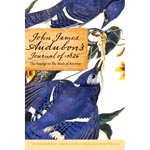Book review: John James Audubon’s journal
Audubon’s observations, which he gathered in 1826 during his journey in England, Scotland and France, make a delightful read


To order any of the books reviewed or any other book in print, at
discount prices* and with free p&p to UK addresses, telephone the Country Life Bookshop on Bookshop 0843 060 0023. Or send a cheque/postal order to the Country Life Bookshop, PO Box 60, Helston TR13 0TP * See individual reviews for CL Bookshop price
Memoirs/nature John James Audubon's Journal of 1826 Edited by Daniel Patterson (University of Nebraska Press, £34, *£30)
When Audubon failed to find a publisher for his Birds of America in the USA, he gambled his and his family's future on succeeding abroad, in England, Scotland and France. The 1826 journal is the prime source for his unlikely success in getting the vast double-elephant folio published. It is now edited for the first time to preserve what he actually wrote, rather than what previous editors thought he should have written. He describes himself as ‘awkward and very shy', but proves a memorable observer, who immediately charmed his way as a long-haired ‘American woodsman'.
Audubon embarked for Liverpool on April 26, his 41st birthday, carrying among his luggage 250 of his life-size ‘watter coloured Drawings' and some letters of introduction to possible subscribers. In America, the Audubons survived through his portrait painting and his wife Lucy's teaching. In England, he had to pretend to be a gentleman artist-naturalist, for whom the ‘needful' was not a problem. This persona was tested within 10 days of his arrival, when Liverpool's Royal Institution exhibited the paintings. Gentlemen did not charge an admission fee. After agonising, he did, and so began making money from his bird pictures. Yet at night, he wept for want of a letter from Lucy, and his journal is addressed to her.
He also felt compromised by his dependence on the patronage of aristocrats on whose land ‘no one dare trespass', offensive to someone used to the democratic freedoms and independence of America. Seeds of success were sown in Liverpool and Manchester, but it was in Edinburgh, renowned as a seat of natural history, that they came to triumphant fruition.
The world-famous novels of Walter Scott had made Scotland for Audubon ‘modern classic ground', displacing Italy and Greece. He was so excited he noted the exact time he crossed the border on October 25. He was lionised in Edinburgh, admired the ‘wonderful Cleanliness of the whole' and thought it the most beautiful city he had ever seen although abhorring the contrast of rich and poor. A continuing lack of letters from Lucy was the only black dog; not until December 10 did he receive hers of August.
Exquisite houses, the beauty of Nature, and how to get the most from your life, straight to your inbox.
On October 30, he showed his work to the printer William Lizars. ‘I slowly unbuckled the straps, and putting a chair for him to set, without uttering a Word, I turned up a Drawing... Mr Lizars, quite surprised, exclaimed: "My God, I never saw any thing like this before."' By November 19, a contract had been agreed and the arduous work of turning the paintings into prints began.
The only grandee he failed to meet was his hero Scott. After yet another rebuff, he lamented: ‘Hundred[s] of times have I said quite Loud in the [American] Woods... Oh, Walter Scott, where art thou? Wilt thou not come to my Country? Wrestle with Mankind and stop their Increasing ravage on Nature and describe her Now for the sake of Future Ages... Without thee, Walter Scott, unknown to the world she must Die.' In the event, it was the Birds of America that served this remarkably prescient need.
A footnote should record their eventual meeting the following year. In Scott's Journal, all is explained: ‘I wish I had gone to see his drawings. But I had heard so much about that I resolved not to see them-a crazy way of mine, your honour!' He liked Audubon. ‘He preferd associating with the Indians to the company of the Back Settlers, very justly I daresay.' But he did not become a subscriber.
* Subscribe to Country Life and up to £50
Country Life is unlike any other magazine: the only glossy weekly on the newsstand and the only magazine that has been guest-edited by His Majesty The King not once, but twice. It is a celebration of modern rural life and all its diverse joys and pleasures — that was first published in Queen Victoria's Diamond Jubilee year. Our eclectic mixture of witty and informative content — from the most up-to-date property news and commentary and a coveted glimpse inside some of the UK's best houses and gardens, to gardening, the arts and interior design, written by experts in their field — still cannot be found in print or online, anywhere else.
